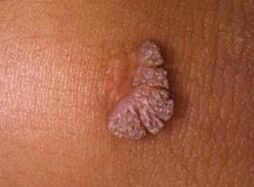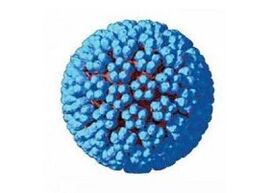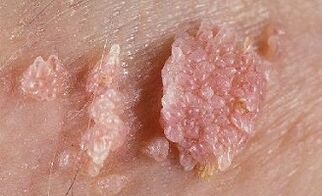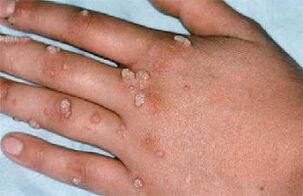
Human papillomavirus (HPV) is a highly human-specific infection of the Papovaviridea family that has the ability to infect and transform epithelial cells.More than a hundred types of HPV have been identified, of which 35 infect the human urogenital tract, causing damage to the covering epithelium of the skin and mucous membranes of the genital organs.
Every sixth person is a carrier of the papillomavirus - this is what WHO data indicates.The infection caused by the papilloma virus is warts (condylomas) and belongs to the group of viral infectious diseases, characterized by the appearance of papillomatous formations on the skin and mucous membrane.HPV is characterized by a chronic form with constant relapses.
Reasons
Why does the human papillomavirus develop and what is it?The causative agent is a virus that affects the upper layer of the skin and mucous membranes of the genital organs.Transmission of these viruses is possible only from person to person;infection occurs through contact with the skin or mucous membranes of a sick person.
Human papillomavirus infection can occur:
- During intercourse.According to the International Medical Association, papillomavirus is one of the most common sexually transmitted diseases, accounting for more than 60% of cases.
- At birth.The infection can be transmitted at birth from a mother to a newborn baby, which subsequently leads to infection with the papilloma virus or laryngeal papillomatosis.
- By autoinoculation.Self-infection can occur if basic hygiene rules are not observed: hair removal or shaving.
- With everyday means.Human papillomavirus is very resistant and can survive for a long time in warm and moist environments in public places, such as toilets, bathrooms, gyms and swimming pools.Infection occurs through various skin lesions directly through contact, use of personal hygiene items or in public places.
Different types of HPV cause or contribute to the development of:

- cervical dysplasia (62%);
- preinvasive and invasive cervical cancer (38%);
- genital warts, urinary tract (51%);
- 10% of clinically healthy women are HPV carriers;
- In 85% of patients with typical genital warts on the external genitalia, the examination reveals additional foci of HPV infection of the vagina and cervix in severe and mild forms.
These data allow us to consider patients with human papillomavirus infections of the genital tract as a group at high risk of developing cervical intraepithelial carcinoma.
Classification
The following classification applies:
- HPV, the manifestation of which are different types of warts (HPV 1-5):
- Plantar warts (looks like a callus), these are HPV types 1-4;
- Flat warts are HPV types 3, 10, 28, 49;
- Common warts are HPV type 27.
- HPV types that affect the vulva, vagina, genitals, cervix, and respiratory tract are HPV types 6, 11, 13, 16, 18, 31, 33, 35.
- HPV whose lesion in the form of rashes is associated with the state of precancerous disease (HPV with high oncogenic risk) is HPV 39 and other types.
As you can see, these benign neoplasms can form in any part of the body:
- door;
- face;
- under the breast;
- in the armpits;
- on the genitals;
- on the mucous membranes of the internal organs, the mouth and the nasal cavity.
The need to treat the human papillomavirus is due to the following fact.The strain is an intracellular parasite incapable of self-replication.For these purposes, he uses the cells of the human body.The virus can parasitize for quite a long time by introducing its own DNA into human chromosomes.Its noticeable activation is observed against the background of reduced immunity.
Incubation period
The incubation period is long: from half a month to several years.Human papillomavirus infection is characterized by a hidden (latent) course.A person can be infected with several types of papillomavirus at the same time.Under the influence of various factors, the virus is activated, its reproduction increases and the disease enters the stage of clinical manifestations.
In most cases (up to 90%), self-healing occurs within 6-12 months, in other cases there is a long-term chronic recurrent course with a possible malignancy of the process (depending on the type of virus).
Symptoms of human papilloma virus
The human immune system is strong enough to overcome the virus at an early stage of its development.And in most cases the disease does not develop.However, over time, months, years or even decades, people may experience some symptoms of HPV infection.
There are several groups of diseases that are most often caused by HPV:
- WartsThey are round growths, harder than the body, with a diameter of 2 mm to 1 cm.The borders of the warts are very clearly defined and there are irregularly shaped warts.They are rough to the touch and can be of different colors.Most often, they form in places where the skin is most damaged: on the hands, knees or elbows.
- Plantar warts.They develop when infected with viruses of type 1 and 2 in the places where the shoes rub or press the feet.The skin at the site of the wart becomes thicker and the warts do not have clear boundaries.
- Pointed condylomas- specific warts that appear, as a rule, on the mucous membranes and skin of the genital organs: the head of the penis and the skin of the foreskin in men, the skin of the labia in women.They can also appear in the bladder, urethra, cervix, vagina, skin around the anus, and in the mouth.Outwardly, these genital warts look like small raised formations, their edges are uneven (they look like cauliflower).This disease is caused by human papillomavirus types 6 and 11.
- Bowenoid papulosis.Small, flat plaques of warts (somewhat similar to flat warts) appear around the genitals.It develops more often in men who constantly change their sexual partners.Called by types – 16, 18, 31, 33, 42, 48, 51, 54.
Any viral infection that is constantly present in the human body (and HPV is one of them) is activated only when immunity decreases.
Human papilloma virus: picture

To understand what the human papilloma virus looks like in various manifestations, we have prepared a photo.
Symptoms of human papillomavirus in women
The infection can proceed in a latent form or cause the development of genital papillomas.Genital warts are mostly seen in women between the ages of 15 and 30.
The main danger of developing a disease caused by types 16 and 18 is the development of cervical cancer.Cervical cancer shortens life expectancy by an average of 26 years.From the point of view of the development of cancer, only the virus that remains in the body for more than a year becomes dangerous.
Unfortunately, these diseases in women are often asymptomatic until the final stages, when the effectiveness of treatment is significantly reduced.
Symptoms of human papillomavirus in men
For men, the human papilloma virus is less dangerous than for women.Most often they are passive carriers.The likelihood of developing cancer is much lower.
HPV in men can cause genital warts on the foreskin, glans or frenulum.Such formations must be urgently removed, as they interfere not only with personal hygiene, but also with sexual activity.
Prevention
We list the main guidelines for the prevention of human papillomavirus infection:
- personal hygiene measures in public places;
- a healthy lifestyle that keeps immunity at a high level;
- proper mode of work and rest;
- moderate physical training;
- intake of vitamins, fruits, juices;
- only one sexual partner (ideally);
- using a condom during intercourse.
Vaccinations against human papillomavirus are currently available.
Treatment of human papillomavirus
Currently, there is no antiviral drug that can cause the human papillomavirus to disappear from the body.
Different interferons and interferonogens can reduce existing condylomas, but do not reduce the frequency of new ones.Therefore, the main method of treatment of the human papilloma virus remains the removal of condylomas by chemical or surgical methods.
Here are the main methods for removing papilloma tissue:
- Radiosurgical.The radio wave electrode cuts the tumor and coagulates the vessels.An antiseptic dressing is then required.
- A laser.Contactless and bloodless method.At the site of the removed papilloma, a crust remains, under which healing takes place.Disadvantages: risk of relapse, high cost, need to polish the remaining scars.
- Electrocoagulation.In terms of efficiency, results and prices, the method is similar to the previous two methods.
- Surgically.This is an operation under local anesthesia.

Before starting treatment, be sure to ask your doctor:
- What treatments are offered at the clinic where you are treated?
- How much does each type of treatment cost and what are the possible complications?
- Will the surgery be painful?
It should be emphasized that the removal of papillomas should not be considered a complete cure of the human papilloma virus infection, since in this case the person does not cease to be a carrier of the virus, i.e.papillary polyps may reappear after several years.Therefore, for the purposes of prevention, doctors recommend improving the health of the entire organism as a whole.
Cryocoagulation
Cryocoagulation (burning with liquid nitrogen) is a fast and effective method of treating genital warts.The procedure may be slightly painful and uncomfortable, but this is rarely of much concern to patients.
Cryocoagulation of condylomas is performed in several sessions over several weeks.Complete elimination of condylomas is observed in 75-80% of patients who have undergone all procedures.
Recommendations for patients
You should not try to diagnose and treat human papillomavirus yourself.
- First, you need to choose the right method.
- Second, there is always a risk of confusing genital warts with a malignant tumor.
It is better not to take risks and entrust your health to professionals - this will ensure you a long and happy sex life.Sexual activity during the treatment of papilloma virus is stopped until full recovery.It is necessary to examine and, if necessary, treat the partner.























